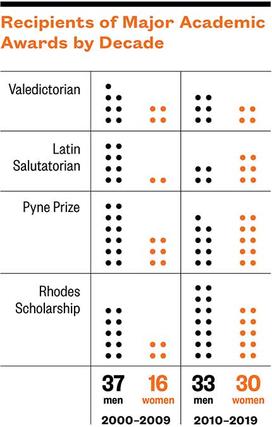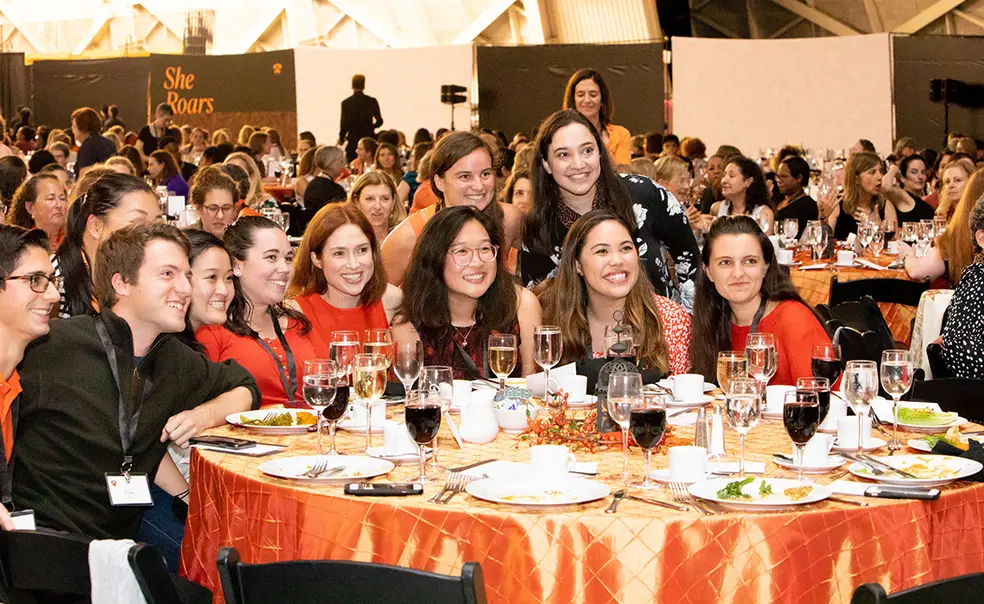Undergraduate Women’s Leadership Appears to be Trending Back Up
Ten years after a campus report, are undergraduate women seeking top roles?
On the 40th anniversary of coeducation at Princeton, then-President Shirley Tilghman assembled a committee to study why relatively few undergraduate women were involved in visible leadership positions at the University. Inspired by discussions and examples of disparities across campus, the group collected data and conducted interviews for a year before releasing its final report in March 2011.
The 100-plus-page report found an upward trend of women in leadership positions from the start of coeducation to the 1990s, but a downturn in the 2000s. Although women outperformed men in most areas of academic achievement, the report found social pressures and expectations led women to “undersell themselves, and sometimes make self-deprecating remarks in situations where men might stress their own accomplishments.” The introduction of the report noted, “Women find many doors closed at Princeton, but few that are actually locked.”

For committee members, the findings were striking. “We found that a lot of women felt that they were engaged in leadership,” said Nannerl Keohane, a former president of Wellesley College and Duke University who chaired the committee while teaching at Princeton. This challenged her original conception of what leadership is, because so many women were involved in ways that the committee characterized as behind-the-scenes, Keohane told PAW in January.
Thomas Dunne, deputy dean of undergraduate students who was also on the committee, said some of the focus-group conversations with women students at the time were disheartening. He recalled students “were saying things like, ‘I don’t think this particular club will ever have a woman president. I just don’t see it.’”
Ten years later, there are anecdotal signs of progress. In 2010, only one woman was serving as president of an eating club; by 2018, nine of the 11 eating clubs had women presidents. Some high-profile undergraduate positions, including president of Undergraduate Student Government and editor-in-chief of The Daily Princetonian, either are currently or were recently held by women. Major awards, including the Pyne Prize, valedictorian, Latin salutatorian, and Rhodes Scholarship, have moved closer to gender parity in the last decade (see chart). Princeton women continue to succeed in the classroom, outpacing men in four-year and six-year graduation rates in each of the seven years of data available on the Registrar’s website.
There are anecdotal signs of progress. In 2010, only one woman was serving as president of an eating club; by 2018, nine of the 11 eating clubs had women presidents.
Back in 2011, the campus community had mixed feelings on the leadership committee’s findings. Some felt the central question of the report was a nonissue, Keohane said. But many were supportive and encouraged that the University was doing something to address the elephant in the room, she added.
The report offered recommendations on how to empower all students to pursue leadership opportunities. Recommendations included revamping freshman orientation to emphasize leadership preparation and connections between first-year and upper-class students, encouraging more mentorship, offering leadership training, and promoting faculty initiatives to help mitigate bias. The report recommended that the University revisit the data in 2019 and update the statistics, as part of the 50th anniversary of undergraduate coeducation at Princeton. According to University spokeswoman Ayana Gibbs, a follow-up review has not taken place.
Dunne said his office has plans to update the numbers. “I know that [the numbers are] significantly better because I work with those students, but I do think there’s value in picking up the conversation again,” he said.
Jemima Williams ’23 said that in her personal experience as a member of Whig-Clio, the Princeton Debate Panel, Matriculate, The Daily Princetonian, and Tiger Chunes (a steel-drum ensemble), she sees women leaders all over campus and finds it inspiring. Williams, a low-income, first-generation student, said she is more interested in understanding how to expand opportunities for students who may face more barriers to getting involved.
While progress can be slow, Keohane is hopeful things are moving in the right direction. “I think Princeton’s closer now than it was 10 years ago,” said Keohane, “but I think none of us [in higher education] has quite gotten there — but I’m hopeful that we will.”
For the Record
The original version of this story reported that a woman was elected president of an eating club for the first time in 2011. That was the year that Ivy Club elected its first woman president. At least seven eating clubs had women presidents prior to 2011.












4 Responses
Carol Zall ’88
4 Years AgoMore Women Presidents of Eating Clubs
In regard to your March, 2021 article stating that the first woman was elected president of an eating club in 2011, I would like to put on record that I was president of Campus Club in 1987-88. At that time, Molly Blieden '88 was also president of Terrace Club, next door. I believe that I was not the first woman president of Campus Club — I recall being told that there was one in the early 1980s.
B. Marc Allen ’95, Ed Franowicz ’95, Ted Frantz ’95, and Glen McGorty ’95
4 Years AgoWomen Leaders in the Class of ’95
Princeton has forgotten its own recent past (“Undergraduate Women’s Leadership Appears to Be Trending Back Up”). Were we able to gather for our 25th reunion last May, we might have helped with digital proof regarding the existence of not one, but two female presidents of eating clubs in the 1990s! Both Alice Ayres ’95 (Campus) and Kathleen Guinee ’95 (Charter) served as presidents of their respective clubs. Our Interclub Council was, in retrospect, a remarkably cohesive group, which manifested in cooperative efforts that helped create a friendly climate among club leaders. Collectively, the Interclub Council worked on a number of issues, most notably a “Statement of Principles” that tried to negotiate a space between the free-flowing culture that had existed before the early ’90s and more draconian and puritan vision encouraged by some University leaders and eating club graduate boards. Alice served as the president of the Interclub Council. She led brilliantly.
To some of us, the significance of Alice and Kathleen’s leadership was utterly unremarkable. We expected it, because our class was filled with a variety of strong female leaders in every domain across campus. Princeton had embraced coeducation; in our lived experience, all of the clubs were coed. We suspect that both Alice and Kathleen are far too busy living life, taking on challenges, and leading in their current roles, to try to correct the historical record. This is in keeping with their style of collaborative leadership, from which we benefitted.
We do not profess to speak for either of them. They faced challenges, obstacles, and potential resentment of their leadership. Neither Alice nor Kathleen ever talked about being the first female presidents on the Street, perhaps because they were not (for instance, a simple search of the Daily Princetonian indicates that Elm’s president in the Class of 1983 was Patty Braverman).
All of this does not undermine the special challenges facing women at Princeton in the ’90s or the present. We look back fondly on the time we spent working with Alice and Kathleen, who are remarkable in every way. We hope that University Leaders and the PAW will acknowledge these pioneers. And a note for those undergraduates looking for great senior thesis topics: You’ve got some work to do!
Editor’s note: Several readers wrote to set the record straight on women who were presidents of their eating clubs. To date, the earliest examples PAW has found are Diana Smith ’80, Tower Club president and chair of the Inter-Club Council, and Leslie Brooks ’80, president of Quadrangle Club.
Amy Briggs ’96
4 Years AgoWomen Presidents of Eating Clubs
Let’s get down to brass tacks: I’m sad to say that there is a major error in the latest edition of the PAW. The article “Looking to Lead: Ten years after a campus report, are undergraduate women seeking top roles?” states: “There are anecdotal signs of progress. In 2011, a woman was elected president of an eating club for the first time.”
That factoid? It’s wrong. At least one elected eating club woman president took office in 1995. She was elected by the members of DEC, the great Dial Elm Cannon Club.
And I know this to be true because, well, I am her and she is me. I served as president of the club formerly known as DEC, which is now beloved as Cannon (if you need a second source, check out the faceboard up on the second floor — I’m the one in the middle with the “Rachel”).
Cheers to women presidents of eating clubs!
Editor’s note: Helen Graves ’81 and Joe Falencki ’04 also wrote to correct this error. In 2011, Ivy Club elected its first woman president, but at least seven eating clubs had women presidents prior to 2011. The article has been updated, and a correction will appear in the April 2021 print issue.
Judy Snyder Kastenberg ’88
4 Years AgoHistory of Female Club officers
Peggy Russell '79, president of Cloister
Kristen Schaefer '88, president of Colonial
Judy Snyder Kastenberg '88, vice-president of Colonial
Vickie Gonzales '88, social chair of Colonial
Jenni Groh '88, social chair of Colonial
Calling other female club officers....